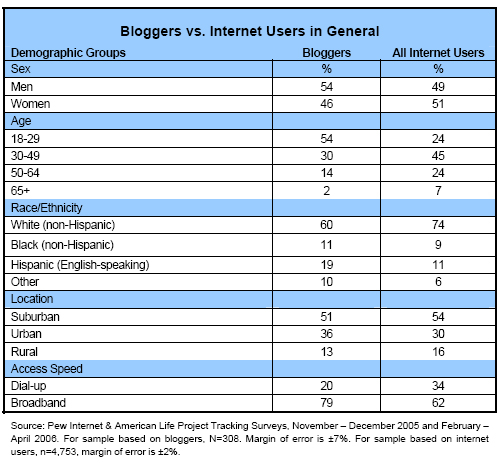Blogging is bringing new voices to the online world.
A telephone survey of a nationally-representative sample of bloggers has found that blogging is inspiring a new group of writers and creators to share their voices with the world.
We find that bloggers blog for many different reasons – some blog to exercise their creative muscles, others want to motivate or influence others. Bloggers may want to stay in touch with family and friends, others want to network and meet new people. Bloggers may use their blog as a way of documenting ideas and events and storing them for later retrieval, while others view it as a way to share, to entertain, and even to earn a living.
Some observers have suggested that blogging is nothing more than the next step in a burgeoning culture of narcissism and exhibitionism spurred by reality TV and other elements of the modern media environment. But others contend that blogging promises a democratization of voices that can now bypass the institutional gatekeepers of mainstream media. This democratization is thought to have implications for the practice and business of journalism as well as the future of civic and political discourse.
The Pew Internet & American Life Project wanted to explore the questions of who, what, where, when and how of blogging by going directly to the source – bloggers themselves. This report details the findings of a callback telephone survey of bloggers conducted over approximately six months in 2005-2006. In standard internet tracking surveys of nationally representative samples of American adults by the Pew Internet & American Life Project, a question is asked of all internet users about whether they maintain a blog. Once several hundred bloggers were identified in those standard surveys, the bloggers were called back and asked questions about their specific motivations, their blogging behaviors, the content of their postings, the features on their blogs, and their views about the impact of their blogs.
The blogging population is young, evenly split between women and men, and racially diverse.
According to random-digit dial surveys conducted in the spring of 2006, 8% of internet users age 18 and older, or about 12 million American adults, report keeping a blog. According to a random-digit dial survey conducted in January 2006, 39% of internet users age 18 and older, or about 57 million American adults, report reading blogs.2 And as described in the Pew Internet Project’s Teen Content Creators and Consumers report,3 19% of internet users age 12-17 keep a blog and 38% of online teens read blogs.
“Internet users” — Respondents who answer yes to at least one of the following questions: “Do you use the internet, at least occasionally?” and “Do you send or receive email, at least occasionally?”
Bloggers are overwhelmingly young adults who hail from urban and suburban areas. They are evenly divided between men and women. Bloggers are less likely than internet users to be white.4
More than half (54%) of bloggers are under the age of 30, and about another third (30%) are between 30 and 50. Just 14% of bloggers fall in the 50 to 64 age group and a tiny 2% are 65 or older. In comparison, only 24% of internet users are age 18-29. Nearly half of internet users (45%) are age 30 to 49 and another quarter (24%) are age 50 to 64. About 7% of internet users are 65 or older.
“Bloggers” — A subset of internet users who answer yes to the following question: “Do you ever create or work on your own online journal or weblog?”
More than half (51%) of bloggers reside in suburban areas, similar to the 54% of internet users who live in the same type of community. Another third (36%) of bloggers live in urban areas, and few bloggers (13%) reside in rural regions, in both cases reflecting a similar distribution of internet users (30% and 16% respectively).
Bloggers are less likely to be white than internet users. While 60% of bloggers are white, 11% are African American, 19% are English-speaking Hispanic and 10% are some other race or ethnicity. By contrast, among internet users 74% are white, 9% are African American, 11% English-speaking Hispanic and 6% are some other race or ethnicity.

